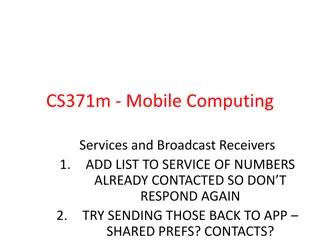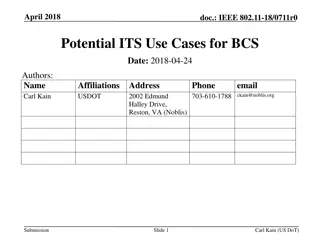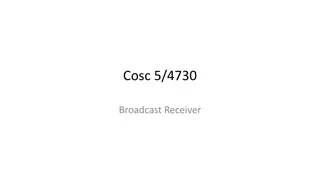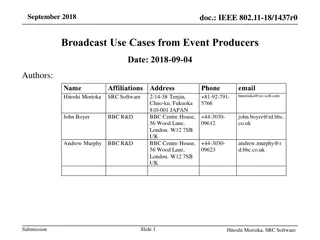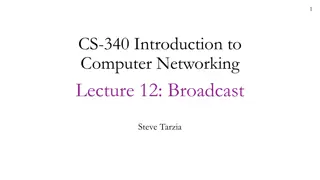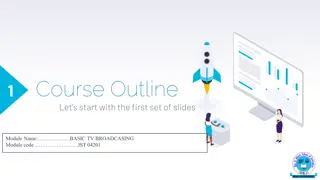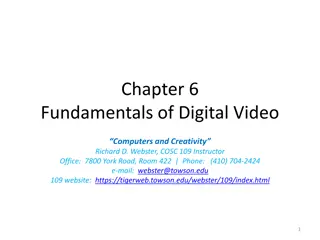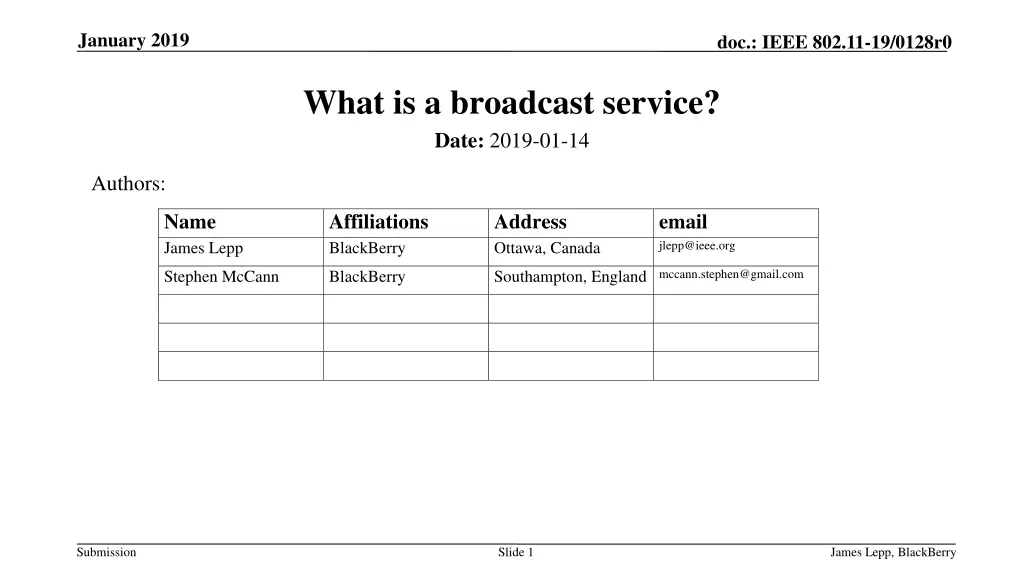
Understanding Broadcast Services in IEEE 802.11
Explore the concept of broadcast services in the IEEE 802.11 standard, focusing on efficient downlink broadcasts, associated and unassociated STA interactions, and the management of available and active services at the Access Point. The document delves into the necessity of maintaining different states for Broadcast Control Services (BCS) and the role of Service Set Identifiers (SSIDs) in managing broadcast transmissions.
Download Presentation

Please find below an Image/Link to download the presentation.
The content on the website is provided AS IS for your information and personal use only. It may not be sold, licensed, or shared on other websites without obtaining consent from the author. If you encounter any issues during the download, it is possible that the publisher has removed the file from their server.
You are allowed to download the files provided on this website for personal or commercial use, subject to the condition that they are used lawfully. All files are the property of their respective owners.
The content on the website is provided AS IS for your information and personal use only. It may not be sold, licensed, or shared on other websites without obtaining consent from the author.
E N D
Presentation Transcript
January 2019 doc.: IEEE 802.11-19/0128r0 What is a broadcast service? Date: 2019-01-14 Authors: Name James Lepp Affiliations BlackBerry Address Ottawa, Canada email jlepp@ieee.org Southampton, England mccann.stephen@gmail.com Stephen McCann BlackBerry Submission Slide 1 James Lepp, BlackBerry
January 2019 doc.: IEEE 802.11-19/0128r0 Abstract What is a broadcast service? Submission Slide 2 James Lepp, BlackBerry
January 2019 doc.: IEEE 802.11-19/0128r0 General downlink broadcasts For purposes of efficiency the AP shouldn t broadcast all services all the time AP shouldn t jam/spam the wireless medium with frames that are of no interest/value to associated/nearby STAs Broadcast Services AP STA3 STA1 STA2 Submission Slide 3 James Lepp, BlackBerry
January 2019 doc.: IEEE 802.11-19/0128r0 Downlink broadcasts BCS AP states For purposes of efficiency the AP shouldn t broadcast all services all the time Maintain different states for the BCS at the AP Available at the AP, and actively transmitting Available at the AP, but not currently transmitting Are there other states? Available Services: BCS1 BCS2 BCS3 BCS4 Active Services: BCS1 BCS2 Broadcast Services AP STA3 STA1 STA2 Submission Slide 4 James Lepp, BlackBerry
January 2019 doc.: IEEE 802.11-19/0128r0 Associated STAs downlink broadcasts For purposes of efficiency the AP shouldn t broadcast all services all the time Broadcast Services (BCS) should be a stateful concept AP tracks which STA is currently receiving the service STAs involved in controlling particular BCS(s) Different models could be considered Could be a start/stop request Could be a request to subscribe/unsubscribe Available Services: BCS1 BCS2 BCS3 Active Services: BCS1 BCS2 Broadcast Services AP Subscribed to: BCS1 STA3 STA1 Subscribed to: BCS2 STA2 Subscribed to: BCS1 BCS2 Submission Slide 5 James Lepp, BlackBerry
January 2019 doc.: IEEE 802.11-19/0128r0 Broadcasts Unassociated STA1 is a sensor broadcasting observed data Data is transmitted as a BCS service STA2 and STA3 are receivers of that information Data is received as a BCS service BCS Transmitter STA1 STA3 STA2 BCS Receiver BCS Receiver Submission Slide 6 James Lepp, BlackBerry
January 2019 doc.: IEEE 802.11-19/0128r0 Broadcast Service ? So what is a Broadcast Service? It needs to be defined at Layer 2. Not based on IGMP, IGMP-snooping and all that interesting IP layer multicast tech But is it designed to better support it? It should not be: Solely multicast addressed frames (we have those already) Is it a new grouping of STAs? If so, how does this work? Create/Clear Down the group Signal to other STAs Control the group Is it a grouping of the frames? Assuming group-addressed frames are used, what properties make a group/set of group addressed frames into something called a broadcast service? Submission Slide 7 James Lepp, BlackBerry





